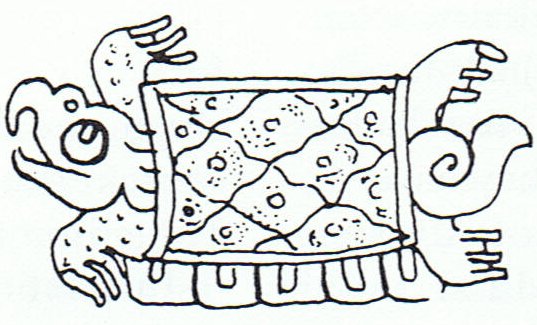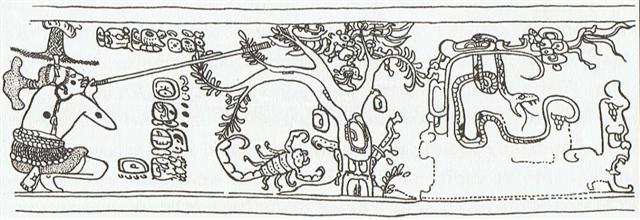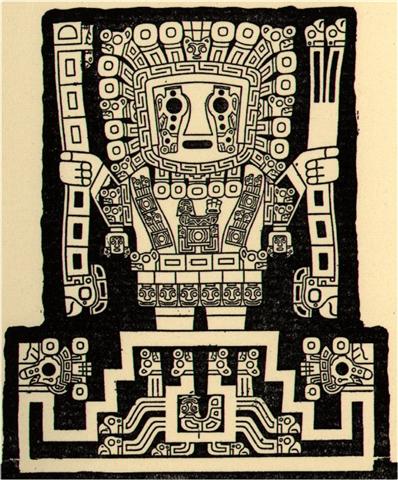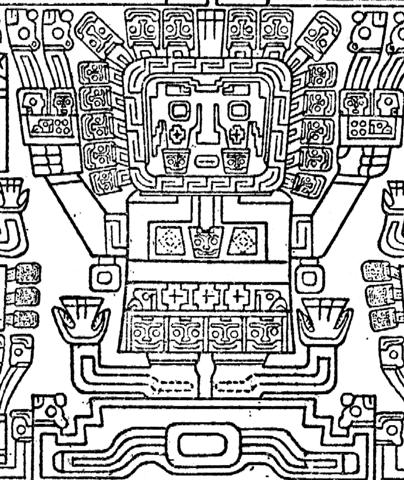At the Chinese 24th lunar station Willow, at glyph number 248 (= 364 - 16 - 100), is the 19th glyph in the line. I guess this willow was Salix Babylonica, the 'Weeping Willow':
Possibly 248 - 229 = 19 indicates a position corresponding to the Mayan last special only 5-day long month Vayeb (Uayeb) with 2 eyes in front (reading the figures like the Mayas from right to left) - and the curve at its top end could correspond to those 5 nuku figures with curves at the top, i.e. 5 as the number of Rei in line Ga8:
A pair of haati ('sacrificed legs') - Gb1-16--27 - should be followed of a pair of 'fruits' (mata). The eye figures at the end of Vayeb evidently belong to the 'Turtle' (Pawahtun), the Middleworld (between Sky and Underworld). She has 4 * 3 = 12 'fingers':
With 20 days in all the other Mayan haab months we perhaps should count back to day 248 - 5 - 60 = 183 at the beginning of 16 Pax.
The structures are similar. What could come beyond the 5 nights of Vayeb? A new haab cycle of course. But the G text may have been disposed in some other way and we can hardly be sure:
A Weeping Willow should reasonably have eyes for generating its tears. I suggest the extraordinary figure in Cb1-21 was meant to illustrate a tree in the dark with a pair of eyes hanging down. "M119. Cayua. 'The jaguar's eyes'. The jaguar learned from the grasshopper that the toad and the rabbit had stolen its fire while it was out hunting, and that they had taken it across the river. While the jaguar was weeping at this, an anteater came along, and the jaguar suggested that they should have an excretory competition. The anteater, however, appropriated the excrement containing raw meat and made the jaguar believe that its own excretions consisted entirely of ants. In order to even things out, the jaguar invited the anteater to a juggling contest, using their eyes removed from the sockets: the anteater's eyes fell back into place, but the jaguar's remained hanging at the top of a tree, and so it became blind. At the request of the anteater, the macuco bird made the jaguar new eyes out of water, and these allowed it to see in the dark. Since that time the jaguar only goes out at night. Having lost fire, it eats meat raw. It never attacks the macuco - in the Apapocuva version, the inhambu bird, also one of the Tinamidae ..." (Claude Lévi-Strauss, The Raw and the Cooked. Introduction to a Science of Mythology: 1.) We can compare with the eyes hanging in the Tree in front of Scorpius. I have reversed the Mayan picture so we can read from left to right:
South of the equator a growing Moon crescent is oriented in the opposite direction compared to how we north of the equator can observe the face of the growing Moon. Therefore the crescents in Cb1-21 could illustrate the growing Moon (a pair of them because months were probably counted in pairs). ... When the new moon appeared women assembled and bewailed those who had died since the last one, uttering the following lament: 'Alas! O moon! Thou has returned to life, but our departed beloved ones have not. Thou has bathed in the waiora a Tane, and had thy life renewed, but there is no fount to restore life to our departed ones. Alas ...
The Sun god standing in the southwest was weeping because his real eyes were gone. The hanging heads at his elbows (equinoxes) suggest the nighttime covered more than half his cycle, possibly 365 - 152 = 213 nights. Although he did his best to be as narrow as possible.
Notice the rising fish at left - it probably was added in order to show the rising Moon. The Sun god in daytime, on the other side, had his arms raised high and his eyes were beaming:
| ||||||||||||||||||||||||||||||||||||||||||||||||||||||||||||||||||||||||||||||||||||||||||||||||||||||||||||||||||||||||||||||||||||||||||||||||||||||||||||||||||||||||||||
























